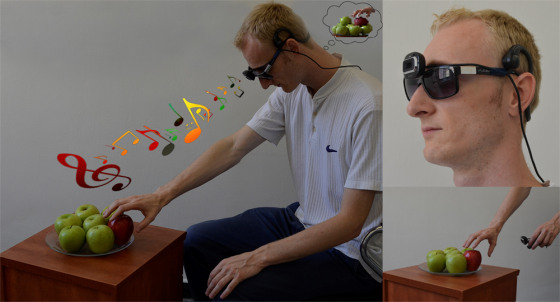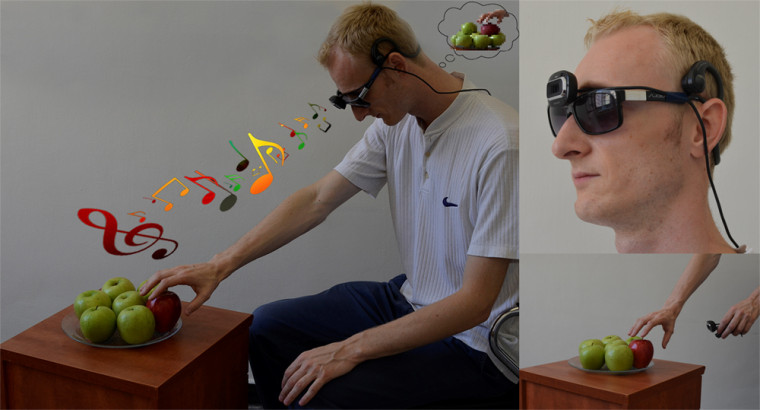A new headset, still in its prototype stage, tells visually impaired people what's in front of them by playing different sounds for different objects. Eventually the headset, called EyeMusic, may be able to help visually impaired people with such everyday tasks as choosing produce at the supermarket, according to EyeMusic's creators.The inventors, a team of neuroscientists at the Hebrew University in Israel, said they proved the feasibility of the device by testing it on sighted people who were blindfolded.
The EyeMusic headset looks like a pair of sunglasses with attached headphones and a webcam mounted on the nose bridge. The camera scans the scene in front of the wearer from left to right. As the camera pans, the earphones play sounds corresponding to the height, color and brightness of what the camera sees.
Higher-pitched notes represent taller objects. Different electronic instruments represent different colors — buzzy vocals indicate white, for example, while digital trumpets play for blue. Brighter colors translate to louder sounds.
"The notes … span five octaves and were carefully chosen by musicians to create a pleasant experience for the users," Amir Amedi, who is leading the research, said in a statement. Amedi published some sample sounds ; they weren't exactly pretty, but they were tolerable.
To test EyeMusic, Amedi and his colleagues trained 18 sighted people to use the headset. Then the researchers blindfolded the study volunteers, gave them EyeMusic headsets to wear and asked them to point to blue and white squares on a tablet device. In a second trial, the researchers asked sighted volunteers to point to blue and white squares on the tablet without wearing a blindfold or EyeMusic.
The scientists found that sighted people could point as quickly and nearly as accurately while blindfolded and wearing EyeMusic as they could using their vision. The results mean it's feasible for visually impaired people to use such a device to help them reach for things, the researchers wrote in a paper appearing in the July issue of the journal Restorative Neurology and Neuroscience.
Visually impaired EyeMusic wearers might use the headset to choose red apples from a pile of red and green ones, EyeMusic's inventors suggested. In the future, EyeMusic might be adapted for Kinect and Xbox games. [ Glove Lets Deaf-Blind People Text Message ]
Amedi has conducted previous research on devices to aid the sightless. In a study he published in May, he taught people who were born blind to use a device similar to EyeMusic. When he scanned their brains while they were using the device, he found activity in the same visual regions that are activated in sighted people. Together, the May and July studies support Amedi's idea that the brain doesn't organize itself by the type of sensory information it gets — such as sight or sound — but by the task it has to do, he wrote.
Follow InnovationNewsDaily on Twitter @News_Innovation, or on Facebook.
More from InnovationNewsDaily:

